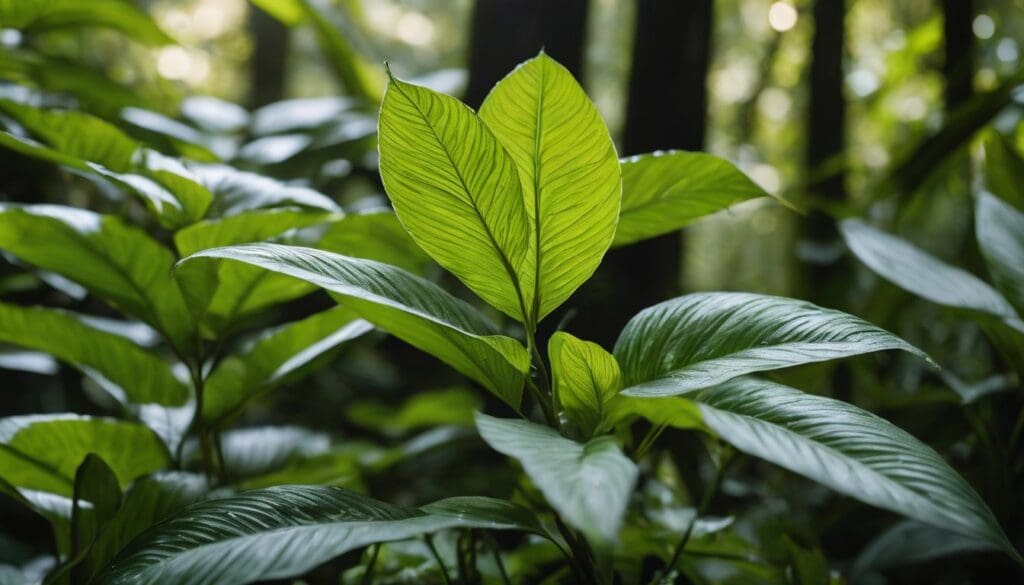As our world grapples with finding harmony between advancing technology and preserving nature, biomimicry emerges as an ingenious approach that marries the two. This revolutionary concept doesn’t just take a leaf out of nature’s book – it studies entire ecosystems to innovate solutions for modern human quandaries.
With decades of experience in ecological research and design, I’ve witnessed firsthand how mimicking the intricate designs and strategies honed by millions of years of evolution can address some of our most pressing environmental issues.
Biomimicry transforms the way we think about innovation: instead of reinventing the wheel, it invites us to consider how nature has already flawlessly designed it. The ingenious application of this science has led to remarkable breakthroughs from self-cleaning surfaces inspired by lotus leaves to energy-efficient buildings modelled after termite mounds.
It’s a testament to nature’s genius serving as humanity’s blueprint for sustainable progress. Keep reading; you’re about to discover how learning from earth’s biodiversity is not just inspiring but also solving problems in ways we never imagined possible.
Key Takeaways
- Biomimicry involves studying and imitating nature’s designs to create sustainable solutions for human challenges, such as creating filters after natural water purification systems or using fungi for green building materials.
- Nature’s innovations have led to practical applications like beetle-inspired white paint that reduces the need for harmful chemicals, moisture-harvesting meshes modelled on insects, and strong underwater adhesives inspired by mussels.
- By emulating natural processes such as how tides clean hemp fibres or spider silk production, biomimicry paves the way for cleaner textile manufacturing and environmentally-friendly construction materials.
- The Biomimicry Institute Community offers a platform for individuals interested in supporting nature-inspired innovation through interdisciplinary collaboration across various fields and industries.
- Individuals can get involved with biomimicry by investing in research, advocating policy changes that encourage its application in industry, participating in educational programs, and joining initiatives promoting ecological design.
What is Biomimicry?
Biomimicry is an innovative approach where scientists, engineers, and designers study nature’s best ideas and then imitate these designs and processes to solve human problems. Think of it as a bridge between biology and technology.
By observing patterns in the natural world—whether it’s how a leaf collects sunlight or how a spider weaves its web—humans can create solutions that are more sustainable and efficient.
This method goes beyond simple inspiration; it requires deep understanding of the principles behind biological systems. Engineers might look at how sharks swim so efficiently to design better boats, or architects could study termite mounds to keep buildings cool without air conditioning.
It’s all about emulating nature’s genius to face our global challenges with smarter, eco-friendly alternatives.
Now let us explore how nature has already solved many of the problems humanity faces today through ingenious adaptations.
Nature’s Solutions to Human Problems
Nature has provided us with many solutions to our problems, such as harnessing molecular water filters, training fungi for green building materials, and mimicking oyster shells for reef restoration.
These innovations are founded on the principles of biomimicry, which seeks to emulate nature’s designs to address human challenges.
Harnessing Nature’s Molecular Water Filter
Nature’s molecular water filter has inspired innovative solutions for addressing the global challenge of clean water access. By studying natural filtration systems, biomimicry researchers have developed advanced technologies that emulate nature’s ability to purify water efficiently and sustainably.
These bioinspired designs draw from the intricate processes found in plants and organisms to create filters that remove contaminants, pathogens, and pollutants from water sources. Biomimetic materials designed after nature’s molecular water filter offer promising solutions for ensuring access to safe drinking water while promoting environmental adaptation and conservation efforts.
Biomimicry offers a new approach to solving human problems by learning from the effective strategies employed by nature over millions of years. Through interdisciplinary collaboration and innovation in engineering, these nature-inspired designs show great promise in providing sustainable solutions for addressing pressing water quality issues globally.
Training Fungi for Green Building Materials
Mimicking nature’s innovation, fungi are being harnessed for the production of eco-friendly building materials. This process, known as mycotecture, involves training fungi to grow and bind agricultural by-products into strong and sustainable composite materials.
Fungi-based building materials have the potential to revolutionise construction practices by offering a renewable alternative to traditional, resource-intensive materials. With their ability to decompose organic matter and self-assemble into lightweight yet durable structures, fungi provide a promising avenue for environmentally conscious individuals seeking sustainable solutions in construction.
Fungi offer an untapped well of potential for green building materials due to their unique properties. These bio-based materials not only reduce environmental impact but also promote circular economy principles by utilising waste streams from agriculture and forestry while reducing reliance on ecologically harmful manufacturing processes.
Mimicking Oyster Shells for Reef Restoration
Oyster shells are being replicated to restore damaged coral reefs. This biomimicry approach harnesses the natural qualities of oyster shells, aiding in reef rebuilding efforts. The material’s composition and structure provide a suitable foundation for new coral growth, boosting marine biodiversity and strengthening coastal defenses against erosion and storms.
By mimicking oyster shells for reef restoration, nature-inspired solutions contribute to the preservation of vital ocean ecosystems while offering sustainable alternatives to traditional restoration methods.
Next topic: “Innovations Inspired by Nature”
Innovations Inspired by Nature
Nature has inspired innovations such as bright white colour from beetles, water capture mesh from insects, underwater adhesive from mussels, and chemical production using light from plants.
Read more about these amazing nature-inspired designs and how they are solving human problems.
Bright White Color from Beetle
The bright white color of the Cyphochilus beetle has inspired scientists to develop a new type of paint that could help in reducing the need for titanium dioxide, which is traditionally used in white paints.
The structure and properties of the scales on the beetle’s shell enable it to reflect light exceptionally well, resulting in an intense whiteness. By studying this natural design, researchers have been able to create a sustainable alternative that has the potential to reduce chemical waste and lower environmental impact.
Scientists are exploring how they can apply this knowledge to produce environmentally friendly coatings and materials with improved optical performance. This biomimetic approach not only offers a more sustainable solution but also demonstrates how nature-inspired designs can lead to practical innovations with significant environmental benefits, all while decreasing our reliance on conventional synthetic materials.
Water Capture Mesh from Insects
Insects have inspired a breakthrough in water capture technology, where researchers are emulating the intricate mesh structures found on the bodies of certain insects. This biomimetic approach aims to develop highly efficient water capture devices that can extract moisture from the air, offering a sustainable solution to water scarcity in arid regions.
By replicating nature’s design, these innovative meshes could provide a cost-effective and eco-friendly way to address global water shortages while minimising energy consumption.
The remarkable resilience and efficiency of insect-inspired water capture mesh offer promising potential for addressing pressing environmental challenges. With this bioinspired technology, scientists and engineers are harnessing nature’s solutions to develop practical and sustainable strategies for securing essential resources like water.
Underwater Adhesive from Mussels
Mussels produce a remarkable underwater adhesive that has inspired the development of bio-inspired glues. These adhesives can be used for medical purposes, repair of ship hulls or even in surgical procedures.
By studying how mussels attach themselves to rocks and other surfaces in high-energy environments, scientists have developed synthetic adhesives with similar properties. The key lies in understanding the unique composition and structure of the proteins found in mussel adhesive threads, enabling them to adhere strongly to wet surfaces.
The underwater adhesive from mussels offers a natural solution for engineering strong and versatile glues that work even in challenging conditions. This innovation holds promise for various applications, including environmental conservation efforts such as reef restoration and sustainable construction materials.
Chemical Production Using Light from Plants
Transitioning from the remarkable adhesive properties of mussels, biomimicry also draws inspiration from plants for chemical production. Plants have long been conducting intricate chemical processes using light energy.
By emulating this natural phenomenon, scientists are exploring ways to use light as a sustainable and renewable energy source for chemical production. Biomimicry taps into nature’s efficient and environmentally friendly methods to develop innovative solutions that align with conservation and sustainability goals.
Plants have evolved to utilise photosynthesis, capturing sunlight to produce complex chemicals essential for their growth and survival. Mimicking these natural processes can pave the way for more eco-friendly and resource-efficient means of manufacturing chemicals, offering promising prospects for sustainable industrial practices inspired by nature’s ingenious design and problem-solving capabilities.
Solving Pollution and Sustainability Issues with Biomimicry
Fungal Remediation of Pollution: Nature has provided us with the ability to harness the power of fungi to clean up pollution, such as in oil spills and other environmental contaminants.
Cleaning Hemp Fibres Inspired by Tides: Biomimicry can help us mimic nature’s processes, like how tides naturally clean hemp fibres, to create sustainable and eco-friendly solutions.
Textile Production Inspired by Spiders: By learning from spiders’ natural silk production, we can revolutionise textile production to be more sustainable and environmentally friendly.
Fungal Remediation of Pollution
Fungal remediation of pollution offers a natural and sustainable solution to mitigate environmental contamination. Fungi have the unique ability to break down pollutants such as oil, pesticides, and heavy metals in soil and water, effectively cleansing the environment.
This nature-inspired approach harnesses the power of fungi to clean up contaminated sites by utilising their enzymatic processes and metabolic activities. By emulating this natural phenomenon, we can address pollution concerns while promoting ecological balance and sustainability.
Utilising fungi for pollution remediation presents a promising avenue for addressing environmental challenges through biomimicry. The application of fungal remediation not only cleanses polluted areas but also aligns with nature’s own mechanisms for restoring balance in ecosystems.
Cleaning Hemp Fibers Inspired by Tides
Hemp fibres, inspired by tides, are being cleaned using nature’s efficient methods. The process mimics the way tides naturally rinse and clean objects on the shore. This innovation presents an eco-friendly alternative to conventional cleaning processes, reducing the environmental impact of textile production.
By drawing from nature’s solutions, this method aligns with biomimicry principles and offers a sustainable approach to hemp fibre processing.
Utilising natural phenomena like tides demonstrates how harnessing nature’s processes can lead to more environmentally friendly practices in various industries. Next, let’s explore another fascinating example where biomimicry is making a significant impact: “Textile Production Inspired by Spiders.”.
Textile Production Inspired by Spiders
Cleaning hemp fibres inspired by tides paves the way for textile production inspired by spiders. Spiders produce silk that is both strong and flexible, making it an ideal model for sustainable textile manufacturing.
By studying spider silk properties, innovative solutions can be developed to create eco-friendly fabrics that are durable and biodegradable. Nature-inspired designs from spider silk can offer a renewable alternative to traditional textiles and address sustainability challenges in the fashion industry.
Mimicking nature’s solutions through biomimicry could revolutionise textile production, offering environmentally conscious individuals a new approach to supporting conservation efforts.
Using biomimicry to emulate the strength and flexibility of spider silk presents an opportunity to create nature-inspired designs with ecological benefits. The application of biologically inspired design in textile production holds promise for addressing systemic problems related to pollution and unsustainable practices within the fashion industry.
The Future of Biomimicry and How to Get Involved
Get involved in the future of biomimicry by supporting nature-inspired problem-solvers, joining the Biomimicry Institute community, and becoming a part of the next generation of nature-inspired innovators.
Interested to learn more about how biomimicry is shaping the future? Read on to discover the exciting world of nature-inspired innovation!
Supporting Nature-Inspired Problem-Solvers
- Investing in research and development of nature – inspired designs to address pressing environmental challenges.
- Collaborating with interdisciplinary teams that work towards integrating biomimicry solutions into everyday human practices.
- Promoting education and awareness about the importance of nature-inspired problem-solving in addressing ecological design and sustainability.
- Advocating for policy changes that encourage the application of biomimicry applications in various industries.
- Participating in initiatives that aim to attune human behaviour with the wider world by embracing nature-inspired innovation.
- Engaging with organisations and communities that support the advancement of biomimicry as a means to solve human problems while conserving natural ecosystems.
Joining the Biomimicry Institute Community
To join the Biomimicry Institute Community, you can support nature-inspired innovation by becoming a part of an interdisciplinary collaborative practice. By engaging with like-minded individuals, you can contribute to attuning human behaviour with the wider world and addressing global challenges. Here are some ways to get involved:
- Collaborate with researchers and industry experts to develop nature – inspired designs and solutions for environmental problems.
- Participate in workshops and seminars focused on nature-inspired problem-solving and sustainable practices.
- Support initiatives that promote biomimicry examples and encourage innovative approaches to sustainability issues.
- Engage in educational programmes that emphasise learning from nature to solve human problems, aligning with the mission of the Biomimicry Institute.
- Connect with a community dedicated to unlocking nature’s secrets and applying them to solve human challenges, promoting interdisciplinary collaboration and creativity.
- Explore opportunities for contributing to nature – inspired design and innovation, emphasising the importance of biomimicry in addressing environmental concerns.
- Advocate for the integration of biomimicry principles into various industries to foster nature – inspired solutions for everyday problems.
Becoming a Part of the Next Generation of Nature-Inspired Innovators.
By becoming a part of the next generation of nature-inspired innovators, you can contribute to solving human problems using nature’s solutions. Biomimicry offers a unique opportunity for environmentally conscious individuals to support conservation and environmental sustainability.
By joining the Biomimicry Institute community, you can play a vital role in learning from nature and applying its principles to address global challenges through innovative and sustainable solutions.
Supporting nature-inspired problem-solvers is crucial for unlocking nature’s secrets and developing practical applications that benefit both humanity and the planet. Through your involvement, you have the chance to be at the forefront of pioneering designs inspired by nature, contributing towards reversing humanity’s negative impact on the environment.
Conclusion
Biomimicry unlocks nature’s secrets for solving human challenges, offering hope for regenerating ecosystems and addressing our impact on the planet. Nature-inspired designs and innovations provide innovative and sustainable solutions that can reverse humanity’s negative impact on the planet.
It is crucial in attuning human behavior with the wider world and addressing global challenges. Biomimicry guides us to learn from nature’s wisdom, inspiring systemic, nature-inspired solutions to tackle environmental issues.
Embracing biomimicry means embracing a future where we work hand in hand with nature to create a sustainable world for generations to come.
FAQs
1. What is biomimicry?
Biomimicry is the practice of designing solutions to human problems by learning from patterns and strategies found in nature.
2. Can you give an example of a nature-inspired innovation?
Yes, one famous example is the invention of Velcro, which was inspired by how burrs stick to animal fur.
3. Is biomimicry only about copying nature’s designs?
No, it’s not just about copying; it’s about understanding the principles behind nature-inspired design and applying them creatively to solve our problems.
4. How does biomimicry benefit us today?
Nature-inspired problem-solving leads to new, sustainable innovations that can improve how we live while reducing our impact on the environment.





